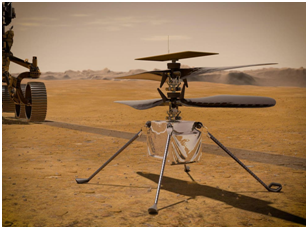NASA's Ingenuity Mars Helicopter | 20 Apr 2021
Why in News
Recently, NASA's miniature robot helicopter Ingenuity performed a successful takeoff and landing on Mars. It was the first powered, controlled flight on another planet.
- The first powered flight on Earth was achieved by the Wright brothers in 1903 in Kitty Hawk, North Carolina.
Key Points
- About Ingenuity:
- Ingenuity is the first helicopter to fly on Mars.
- It was carried by NASA’s rover called Perseverance that was launched in July 2020.
- Ingenuity is able to fly using counter-rotating blades that spin at about 2,400 rpm (Rotations Per Minute).
- It has a wireless communication system, and is equipped with computers, navigation sensors, and two cameras.
- It is solar-powered, able to charge on its own.
- Mission of the Helicopter:
- The helicopter’s mission is experimental in nature and completely independent of the rover’s science mission.
- It will help collect samples from the surface from locations where the rover cannot reach.
- Importance of this Flight:
- Its performance during these experimental test flights will help inform decisions about small helicopters for future Mars missions — where they can perform a support role as robotic scouts, surveying terrain from above, or as full standalone science craft carrying instrument payloads.
- NASA’s Perseverance Rover:
- Perseverance landed at the Jezero Crater (an ancient river delta that has rocks and minerals that could only form in water) of Mars in February 2021.
- It will remain on the Red Planet for about two years and look for finding past signs of life.
- The rover is designed to study signs of ancient life, collect samples that might be sent back to Earth during future missions and test new technology that might benefit future robotic and human missions to the planet.
Mars
- Size and Distance:
- It is the fourth planet from the Sun and the second-smallest planet in the Solar System. It is also called ‘Red Planet’.
- Mars is about half the size of Earth.
- Similarity to the Earth (Orbit and Rotation):
- As Mars orbits the Sun, it completes one rotation every 24.6 hours, which is very similar to one day on Earth (23.9 hours).
- Mars' axis of rotation is tilted 25 degrees with respect to the plane of its orbit around the Sun. This is similar with Earth, which has an axial tilt of 23.4 degrees.
- Like Earth, Mars has distinct seasons, but they last longer than seasons on Earth since Mars takes longer to orbit the Sun (because it's farther away).
- Martian days are called sols—short for ‘solar day’.
- Mars has two small moons, Phobos and Deimos, that may be captured asteroids.
- India’s Mars Orbiter Mission (MOM) or Mangalyaan:
- It was launched from the Satish Dhawan Space Centre in Andhra Pradesh by Indian Space Research Organisation in November 2013.
- It was launched on board a PSLV C-25 rocket with aim of studying Martian surface and mineral composition as well as scan its atmosphere for methane (an indicator of life on Mars).

